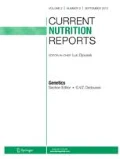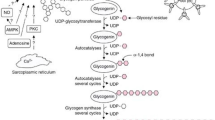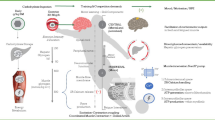Abstract
Purpose of Review
During a soccer season, athletes tend to play intense and light matches such as decisive and qualifying games. The amount of muscle glycogen stores is a determining factor of performance during exercise, and manipulation of carbohydrate intake during the soccer season to enhance muscle glycogen stores can improve the performance of elite soccer players. The purpose of this review is to provide a holistic view of the periodization of carbohydrates and their effects on sports performance, based on what the literature recommends for the periodization of carbohydrates for endurance athletes, and of muscle glycogen recovery and compensation among professional soccer players.
Recent Findings
The ingestion of large amounts of carbohydrates (CHO;10 g/kg of body weight (BW)/day) is important 36 h before a match for the elite soccer player to ensure muscle glycogen supercompensation. In addition, elite soccer players should intake 1 to 1.5 g/kg BW/h within the first 4 h after a soccer game to maximize glycogen resynthesis. However, the season is comprised of away and home games that require different intensities; thus, soccer players need to periodize CHO intake based on evidence-based recommendations such as “train low,” “train low, compete high,” and/or “sleep low.” The goal is to induce training adaptations by alternating with high or low CHO availability based on seasons, matches, and training intensities. The strategy can result in improved performance during games.
Summary
Periodizing the consumption of carbohydrates, based on the intensity of training and matches, should include more carbohydrates when the matches require higher intensity and fewer carbohydrates when they require lower intensity; this is a strategy that will improve the performance of elite soccer athletes.
Similar content being viewed by others
References
Papers of particular interest, published recently, have been highlighted as: • Of importance •• Of major importance
Ribeiro RN, Costa LOP. Análise epidemiológica de lesões no futebol de salão durante o XV Campeonato Brasileiro de Seleções Sub 20. Rev Bras Med Esporte. 2006;12(1):2–6.
Weber FS, da Silva BGC, Radaelli R, Paiva C, Pinto RS. Avaliação isocinética em jogadores de futebol profissional e comparação do desempenho entre as diferentes posições ocupadas no campo. Rev Bras Med Esporte. 2010;16(4):264–8. https://doi.org/10.1590/S1517-86922010000400006.
Bangsbo J, Mohr M, Krustrup P. Physical and metabolic demands of training and match-play in the elite football player. J Sports Sci. 2006;24(7):665–74. https://doi.org/10.1080/02640410500482529.
Mohr M, Krustrup P, Bangsbo J. Match performance of high-standard soccer players with special reference to development of fatigue. J Sports Sci. 2003;21(7):519–28. https://doi.org/10.1080/0264041031000071182.
Lago-Penas C, Rey E, Lago-Ballesteros J, Casáis L, Domínguez E. The influence of a congested calendar on physical performance in elite soccer. J Strength Cond Res. 2011;25(8):2111–7. https://doi.org/10.1519/JSC.0b013e3181eccdd2.
Hearris MA, Hammond KM, Fell JM, Morton JP. Regulation of muscle glycogen metabolism during exercise: implications for endurance performance and training adaptations. Nutrients. 2018;10(3):1–21. https://doi.org/10.3390/nu10030298.
Cermak NM, Van Loon LJC. The use of carbohydrates during exercise as an ergogenic aid. Sports Med. 2013;43(11):1139–55. https://doi.org/10.1007/s40279-013-0079-0.
Impey SG, Hearris MA, Hammond KM, Bartlett JD, Louis J, Close GL, et al. Fuel for the work required: a theoretical framework for carbohydrate periodization and the glycogen threshold hypothesis. Sports Med. 2018;48(5):1031–48. https://doi.org/10.1007/s40279-018-0867-7.
Mata-Ordoñez F, Grimaldi-Puyana M, Sánchez-Oliver AJ. Reposición del glucógeno muscular en la recuperación del deportista. Sport TK-Revista Euroam Ciencias del Deport. 2019;8(1):57–66. https://doi.org/10.6018/sportk.362071.
Chryssanthopoulos C, Williams C, Nowitz A, Bogdanis G. Skeletal muscle glycogen concentration and metabolic responses following a high glycaemic carbohydrate breakfast. J Sports Sci. 2004;22(11–12):1065–71. https://doi.org/10.1080/02640410410001730007.
•• Anderson L, Orme P, Naughton RJ, Close GL, Milsom J, Rydings D, et al. Energy intake and expenditure of professional soccer players of the English Premier league: evidence of carbohydrate periodization. Int J Sport Nutr Exerc Metab. 2017;27(3):128–38. https://doi.org/10.1123/ijsnem.2016-0259A recent study in the English Premier League evaluated the caloric expenditure and total caloric intake of soccer players at 5 training days and 2 days of games, and as a result, total energy intake was higher (p < 0.05) in match days instead of training days, reflecting a higher daily carbohydrate intake on game days compared to training days.
Burke LM, van Loon LJC, Hawley JA. Postexercise muscle glycogen resynthesis in humans. J Appl Physiol. 2016;122(5):1055–67. https://doi.org/10.1152/japplphysiol.00860.2016.
Jeukendrup AE. Nutrition for endurance sports: marathon, triathlon, and road cycling. J Sports Sci. 2011;29(SUPPL. 1):S91–99. https://doi.org/10.1080/02640414.2011.610348
Wright DA, Sherman WM, Dernbach AR. Carbohydrate feedings before, during, or in combination improve cycling endurance performance. J Appl Physiol. 2017;71(3):1082–8. https://doi.org/10.1152/jappl.1991.71.3.1082.
Briggs MA, Harper LD, McNamee G, Cockburn E, Rumbold PLS, Stevenson EJ, et al. The effects of an increased calorie breakfast consumed prior to simulated match-play in academy soccer players. Eur J Sport Sci. 2017;17(7):858–66. https://doi.org/10.1080/17461391.2017.1301560.
Harper LD, Hunter R, Parker P, Goodall S, Thomas K, Howatson G, et al. Test-retest reliability of physiological and performance responses to 120 minutes of simulated soccer match play. J Strength Cond Res. 2016;30(11):3178–86. https://doi.org/10.1519/JSC.0000000000001400.
Burelle Y, Lamoureux M-C, Pèronnet F, Massicotte D, Lavoie C. Comparison of exogenous glucose, fructose and galactose oxidation during exercise using C-labelling. Br J Nutr. 2006;96(01):56. https://doi.org/10.1079/bjn20061799.
Fuchs CJ, Gonzalez JT, van Loon LJC. Fructose co-ingestion to increase carbohydrate availability in athletes. J Physiol. 2019;597(14):3549–60. https://doi.org/10.1113/JP277116.
Currell K, Urch J, Cerri E, Jentjens RLP, Blannin AK, Jeukendrup AE. Plasma deuterium oxide accumulation following ingestion of different carbohydrate beverages. Appl Physiol Nutr Metab. 2008;33(6):1067–72. https://doi.org/10.1139/H08-084.
Jeukendrup A. A step towards personalized sports nutrition: carbohydrate intake during exercise. Sport Med. 2014;44(SUPPL.1): s25–s33. https://doi.org/10.1007/s40279-014-0148-z
Russell M, Kingsley M. The efficacy of acute nutritional interventions on soccer skill performance. Sports Med. 2014;44(7):957–70. https://doi.org/10.1007/s40279-014-0184-8.
Harper LD, Stevenson EJ, Rollo I, Russell M. The influence of a 12% carbohydrate-electrolyte beverage on self-paced soccer-specific exercise performance. J Sci Med Sport. 2017;20(12):1123–9. https://doi.org/10.1016/j.jsams.2017.04.015.
Harper LD, Briggs MA, McNamee G, West DJ, Kilduff LP, Stevenson E, et al. Physiological and performance effects of carbohydrate gels consumed prior to the extra-time period of prolonged simulated soccer match-play. J Sci Med Sport. 2016;19(6):509–14. https://doi.org/10.1016/j.jsams.2015.06.009.
Owen JA, Kehoe SJ, Oliver SJ. Influence of fluid intake on soccer performance in a temperate environment. J Sports Sci. 2013;31(1):1–10. https://doi.org/10.1080/02640414.2012.720701.
Samuel P, Hills MR. Carbohydrates for soccer: a focus on skilled actions and half-time practices. Nutrients. 2017;10(1):22. https://doi.org/10.3390/nu10010022.
Bradley WJ, Morehen JC, Haigh J, Clarke J, Donovan TF, Twist C, et al. Muscle glycogen utilisation during Rugby match play: effects of pre-game carbohydrate. J Sci Med Sport. 2016;19(12):1033–8. https://doi.org/10.1016/j.jsams.2016.03.008.
Krustrup P, Ortenblad N, Nielsen J, et al. Maximal voluntary contraction force, SR function and glycogen resynthesis during the Wrst 72 h after a high-level competitive soccer game. Eur J Appl Physiol. 2011;111(12):2987–95. https://doi.org/10.1007/s00421-011-1919-y.
Ranchordas MK, Dawson JT, Russell M. Practical nutritional recovery strategies for elite soccer players when limited time separates repeated matches. J Int Soc Sports Nutr. 2017;14(1):1–14. https://doi.org/10.1186/s12970-017-0193-8.
Burke LM, Kiens B, Ivy JL. Carbohydrates and fat for training and recovery. J Sports Sci. 2004;22(1):15–30. https://doi.org/10.1080/0264041031000140527.
Plant PJ, Brooks D, Faughnan M, Bayley T, Bain J, Singer L, et al. Cellular markers of muscle atrophy in chronic obstructive pulmonary disease. Am J Respir Cell Mol Biol. 2010;42(4):461–71. https://doi.org/10.1165/rcmb.2008-0382OC.
Lee C-H, Inoki K, Guan K-L. mTOR pathway as a target in tissue hypertrophy. Annu Rev Pharmacol Toxicol. 2007;47(1):443–67. https://doi.org/10.1146/annurev.pharmtox.47.120505.105359.
Close GL, Hamilton DL, Philp A, Burke LM, Morton JP. New strategies in sport nutrition to increase exercise performance. Free Radic Biol Med. 2016;98:144–58. https://doi.org/10.1016/j.freeradbiomed.2016.01.016.
Smiles WJ, Hawley JA, Camera DM. Effects of skeletal muscle energy availability on protein turnover responses to exercise. J Exp Biol. 2016;219(2):214–25. https://doi.org/10.1242/jeb.125104.
Egan B, Carson BP, Garcia-Roves PM, Chibalin AV, Sarsfield FM, Barron N, et al. Exercise intensity-dependent regulation of peroxisome proliferator-activated receptor γ coactivator-1α mRNA abundance is associated with differential activation of upstream signalling kinases in human skeletal muscle. J Physiol. 2010;588(10):1779–90. https://doi.org/10.1113/jphysiol.2010.188011.
Kahn BB, Alquier T, Carling D, Hardie DG. AMP-activated protein kinase: ancient energy gauge provides clues to modern understanding of metabolism. Cell Metab. 2005;1(1):15–25. https://doi.org/10.1016/j.cmet.2004.12.003.
Sean L, Van BJW, Kirsten F, Jonathan D. AMP-activated protein kinase regulates GLUT4 transcription by phosphorylating histone deacetylas reproduced with permission of the copyright owner. Diabetes. 2008;57(April):860–867. https://doi.org/10.2337/db07-0843.
Lantier L, Fentz J, Mounier R, Leclerc J, Treebak JT, Pehmøller C, et al. AMPK controls exercise endurance, mitochondrial oxidative capacity, and skeletal muscle integrity. FASEB J. 2014;28(7):3211–24. https://doi.org/10.1096/fj.14-250449.
Coffey VG, Zhong Z, Shield A, Canny BJ, Chibalin AV, Zierath JR, et al. Early signaling responses to divergent exercise stimuli in skeletal muscle from well-trained humans. FASEB J. 2006;20(1):190–2. https://doi.org/10.1096/fj.05-4809fje.
Marquet L-A, Brisswalter J, Louis J, et al. Enhanced endurance performance by periodization of carbohydrate intake. Med Sci Sports Exerc. 2016;48(4):663–72. https://doi.org/10.1249/MSS.0000000000000823.
Bartlett JD, Hawley JA, Morton JP. Carbohydrate availability and exercise training adaptation: too much of a good thing? Eur J Sport Sci. 2015;15(1):3–12. https://doi.org/10.1080/17461391.2014.920926.
Rabassa-Blanco J, Palma-Linares I. Efectos de los suplementos de proteína y aminoácidos de cadena ramificada en entrenamiento de fuerza: Revisión bibliográfica. Rev Esp Nutr Humana y Diet. 2017;21(1):55–73. https://doi.org/10.14306/renhyd.21.1.220.
Greenhaff PL, Karagounis LG, Peirce N, Simpson EJ, Hazell M, Layfield R, et al. Disassociation between the effects of amino acids and insulin on signaling, ubiquitin ligases, and protein turnover in human muscle. Am J Physiol Endocrinol Metab. 2008;295(3):595–604. https://doi.org/10.1152/ajpendo.90411.2008.
Impey SG, Hammond KM, Shepherd SO, et al. Fuel for the work required: a practical approach to amalgamating train-low paradigms for endurance athletes. Phys Rep. 2016;4(10):1–15. https://doi.org/10.14814/phy2.12803.
Loureiro LMR, Reis CEG, Da Costa THM. Effects of coffee components on muscle glycogen recovery: a systematic review. Int J Sport Nutr Exerc Metab. 2018;28(3):284–93. https://doi.org/10.1123/ijsnem.2017-0342.
Louis J, Marquet LA, Tiollier E, Bermon S, Hausswirth C, Brisswalter J. The impact of sleeping with reduced glycogen stores on immunity and sleep in triathletes. Eur J Appl Physiol. 2016;116(10):1941–54. https://doi.org/10.1007/s00421-016-3446-3.
• Burke LM, Hawley JA, Wong SHS, Jeukendrup AE. Carbohydrates for training and competition. J Sports Sci. 2011;29(SUPPL. 1):S17–S27. https://doi.org/10.1080/02640414.2011. The athlete can ingest large amounts of CHO (approximately 10 g kg−1 of body weight) around 36 h before the competition to ensure muscle glycogen overcompensation.
Lane SC, Camera DM, Lassiter DG, Areta JL, Bird SR, Yeo WK, et al. Effects of sleeping with reduced carbohydrate availability on acute training responses. J Appl Physiol. 2015;119(6):643–55. https://doi.org/10.1152/japplphysiol.00857.2014.
Van Proeyen K, Szlufcik K, Nielens H, Ramaekers M, Hespel P. Beneficial metabolic adaptations due to endurance exercise training in the fasted state. J Appl Physiol. 2011;110(1):236–45. https://doi.org/10.1152/japplphysiol.00907.2010.
Marquet LA, Hausswirth C, Molle O, Hawley J, Burke L, Tiollier E, et al. Periodization of carbohydrate intake: short-term effect on performance. Nutrients. 2016;8(12):1–13. https://doi.org/10.3390/nu8120755.
Movement H, Theses S, Wynne JL, Wynne JL. Effects of high-carbohydrate versus mixed-macronutrient meals on soccer physiology and performance. Hum Mov Sci ODU Digit Commons. 2019. https://doi.org/10.25777/h0ep-sy43.
Kizzi J, Sum A, Houston FE, Hayes LD. Influence of a caffeine mouth rinse on sprint cycling following glycogen depletion. Eur J Sport Sci. 2016;16(8):1087–94. https://doi.org/10.1080/17461391.2016.1165739.
Caruana Bonnici D, Greig M, Akubat I, Sparks SA, Bentley D, Mc Naughton LR. Nutrition in soccer: a brief review of the issues and solutions. J Sci Sport Exerc. 2019;1(1):3–12. https://doi.org/10.1007/s42978-019-0014-7.
• Routledge HE, Graham S, Michele R Di, et al. Training load and carbohydrate periodization practices of elite male Australian football players: evidence of fueling for the work required. International Journal of Sport Nutrition and Exercise Metabolism. 2020;30(4):280–286. https://doi.org/10.1123/ijsnem.2019-0311. The carbohydrate consumption of soccer players in away and home games of season concluded that athletes were consuming less calories with the course of the matches, less carbohydrates and more proteins on home games and more fats on away games, and they were not using sports drinks to rehydrate or improve performance 59. That is why it is understood that soccer players apparently perform some type of nutritional periodization.
Author information
Authors and Affiliations
Corresponding author
Ethics declarations
Conflict of Interest
Haniel Soares fernandes declares that he has no conflict of interest.
Human and Animal Rights and Informed Consent
This article does not contain any studies with human or animal subjects performed by any of the authors.
Additional information
Publisher’s Note
Springer Nature remains neutral with regard to jurisdictional claims in published maps and institutional affiliations.
This article is part of the Topical Collection on Sports Nutrition
Rights and permissions
About this article
Cite this article
Fernandes, H.S. Carbohydrate Consumption and Periodization Strategies Applied to Elite Soccer Players. Curr Nutr Rep 9, 414–419 (2020). https://doi.org/10.1007/s13668-020-00338-w
Accepted:
Published:
Issue Date:
DOI: https://doi.org/10.1007/s13668-020-00338-w




